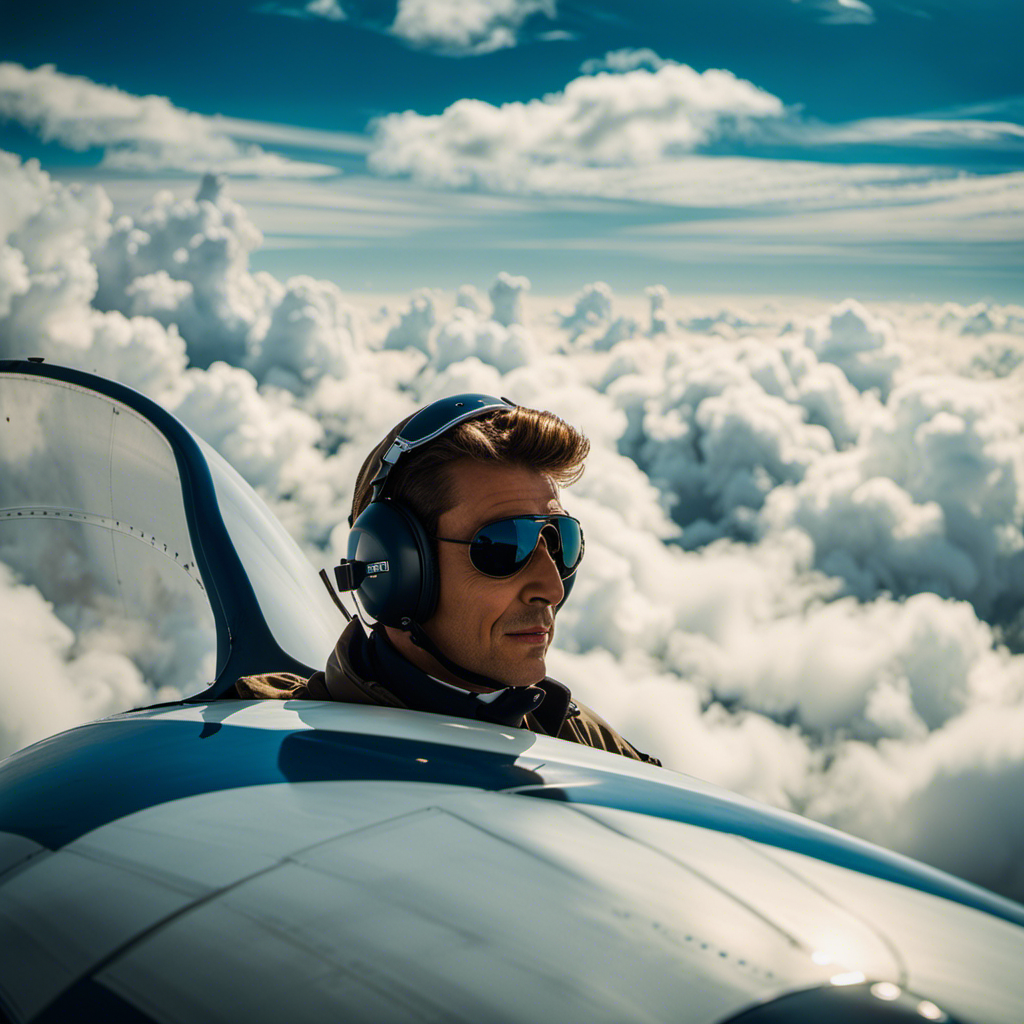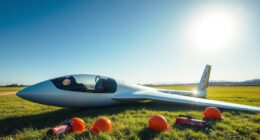As I soar through the expansive sky, I am filled with a thrilling sense of freedom and exhilaration. Learning to become a hang gliding pilot has broadened my horizons, providing me with a fresh perspective to appreciate the world.
If you’ve ever dreamt of defying gravity and feeling the wind beneath your wings, then you’re in the right place. In this article, I’ll guide you through the steps to becoming a hang glider pilot, from understanding the principles of aerodynamics to joining competitions and events.
Get ready to embark on an extraordinary journey into the world of flight.
Key Takeaways
- Prioritize safety precautions and regulations.
- Continuously train and practice to improve skills.
- Obtain certification and licensing through a comprehensive training program.
- Gain experience by flying solo and participating in competitions and events.
Understand the Basics of Aerodynamics
To become a hang glider pilot, it’s important to understand the basics of aerodynamics. Understanding lift and drag is crucial in order to control and maneuver the glider effectively.
Lift is the force that keeps the glider in the air, generated by the shape of the wing and the flow of air over it. Drag, on the other hand, is the resistance the glider experiences as it moves through the air.
By exploring different wing designs, such as the Rogallo wing or the delta wing, pilots can gain a deeper understanding of how aerodynamics affect the performance and stability of the glider. With this knowledge, pilots can make informed decisions and adjustments while flying.
Now, let’s transition into the next section and find a reputable hang gliding school to further develop our skills and knowledge.
Find a Reputable Hang Gliding School
When looking for a reputable hang gliding school, you should research the instructors’ qualifications and check for positive reviews from previous students. It is essential to choose the right instructor who can provide you with the necessary skills and knowledge to become a competent hang glider pilot. To help you in your search, I have compiled a table below outlining some options for hang gliding schools, along with key information such as location, instructor certifications, and student reviews. This will give you a better understanding of the available choices and help you make an informed decision. Once you have found a suitable hang gliding school, it is time to take beginner lessons and start your journey towards becoming a hang glider pilot.
| Hang Gliding School | Location | Instructor Certifications | Student Reviews |
|---|---|---|---|
| Sky High Gliders | California | USHPA Certified | "The instructors were knowledgeable and patient." |
| Soaring Heights Hang Gliding | Colorado | USHPA Certified | "Great school with amazing instructors!" |
| Wind Rider Hang Gliding School | North Carolina | USHPA Certified | "Highly recommend this school for beginners!" |
| Cloud 9 Hang Gliding Academy | Tennessee | USHPA Certified | "Excellent instruction and breathtaking views!" |
| Glider Adventures | Oregon | USHPA Certified | "Best hang gliding experience I’ve ever had!" |
Finding a reputable hang gliding school is crucial in your journey to becoming a hang glider pilot. Once you have chosen the right instructor, it’s time to take beginner lessons and start your hands-on training.
Take Beginner Lessons
Once you’ve found a reputable hang gliding school, you’ll start by taking beginner lessons to learn the fundamentals. Hang gliding offers numerous benefits as a recreational activity. It allows you to experience the thrill of flying while being one with nature. The sense of freedom and exhilaration you feel as you soar through the sky is truly unmatched.
However, it is important to avoid common mistakes during your beginner hang gliding lessons. One common mistake is not paying attention to the instructor’s instructions. It is crucial to listen carefully and follow their guidance to ensure your safety. Another mistake is rushing the learning process. Hang gliding requires patience and practice to master the necessary skills. By taking your time and focusing on each step, you’ll build a solid foundation for your future flights.
As you progress through your lessons, it’s important to start thinking about obtaining the necessary gear.
Obtain the Necessary Gear
When it comes to obtaining the necessary gear for hang gliding, there are a few key points to keep in mind.
First and foremost, it is crucial to invest in a quality hang glider. This will ensure that you have a reliable and safe piece of equipment to use during your flights.
Additionally, it is essential to purchase safety equipment such as a helmet, harness, and emergency parachute to protect yourself in case of any unforeseen circumstances.
Lastly, if you’re just starting out and unsure about committing to the sport, considering renting gear initially can be a cost-effective option to test the waters before making a larger investment.
Invest in a Quality Hang Glider
To become a hang glider pilot, you should definitely invest in a quality hang glider. Having a reliable and well-maintained hang glider is crucial for a safe and enjoyable flying experience. Regular maintenance, including inspecting the glider’s frame, checking the control cables, and ensuring the wing fabric is in good condition, is essential to keep your hang glider in optimal shape.
Additionally, choosing the right flying locations is important. Look for areas with suitable wind conditions and ample space for takeoff and landing. Avoid flying near power lines, trees, or other obstacles that could pose a safety risk.
Now that you have your hang glider ready, the next step is to purchase the necessary safety equipment to ensure a secure flight.
Purchase Safety Equipment
Now that you’ve got your hang glider, it’s important to purchase the necessary safety equipment for a secure flight. Safety regulations are paramount in the world of hang gliding, and having the right gear can make all the difference. Here are four essential items to consider when purchasing your safety equipment:
-
Helmet: A helmet is crucial to protect your head from potential impacts during flight. Look for a helmet that is specifically designed for hang gliding, with features such as a hard outer shell and comfortable padding.
-
Harness: The harness connects you to the hang glider and provides support and stability. It should fit snugly and have sturdy straps and buckles to ensure a secure attachment.
-
Reserve parachute: In case of emergencies, a reserve parachute can be a lifesaver. Make sure to choose one that is suitable for hang gliding and meets safety standards.
-
Flight suit: A flight suit not only protects you from the elements but also provides some level of insulation. Look for a suit that is comfortable, durable, and designed for hang gliding.
Considering the importance of proper safety equipment, it’s crucial to invest in high-quality gear that meets safety regulations. However, if you’re just starting out and aren’t ready to commit to purchasing all the necessary equipment, consider renting gear initially. This will allow you to get a feel for the sport and ensure that hang gliding is something you want to pursue before making a significant investment.
Consider Renting Gear Initially
If you’re unsure about committing to purchasing all the necessary safety equipment, renting gear initially is a great option to explore. Renting gear allows you to try out different types of equipment and find what works best for you before making a significant financial investment.
When renting gear, it’s essential to prioritize safety precautions. Ensure that the gear you rent is in good condition and meets all safety standards. Take the time to familiarize yourself with the equipment and understand how to use it properly. Don’t be afraid to ask questions or seek guidance from experienced pilots or instructors.
Continue Training and Practice
Keep practicing and honing your skills to become a skilled hang glider pilot. As you continue your training, you will have the opportunity to learn advanced techniques that will elevate your flying abilities to new heights. Here are some key areas to focus on:
-
Aerodynamics: Understanding the principles of flight and how they apply specifically to hang gliders will enhance your overall control and efficiency.
-
Weather analysis: Developing the ability to assess weather conditions and make informed decisions based on wind patterns, thermals, and other factors is crucial for safe and successful flights.
-
Emergency procedures: Learning how to handle unexpected situations, such as equipment malfunctions or sudden changes in weather, will ensure you can respond effectively and maintain control.
Obtain Certification and Licensing
To obtain certification and licensing, you need to demonstrate your competence and commitment to safety in hang gliding. The certification process involves completing a comprehensive training program that covers both theoretical knowledge and practical skills. You will learn about aerodynamics, weather patterns, emergency procedures, and navigation techniques. Additionally, you will undergo rigorous flight training sessions under the guidance of experienced instructors. These training sessions will assess your ability to launch, control, and land the hang glider safely.
Once you have completed the certification process, you will need to fulfill the licensing requirements set by your local aviation authority. This typically involves passing written exams and practical flight tests. The exams will evaluate your understanding of the rules and regulations governing hang gliding, as well as your knowledge of safety procedures. The flight tests will assess your ability to apply this knowledge in real-world scenarios.
With your certification and license in hand, you are now ready to fly solo and gain experience.
Fly Solo and Gain Experience
Once you have obtained your certification and license, you can start flying solo and gaining valuable experience.
As a hang glider pilot, safety precautions are of utmost importance. Before takeoff, I always make sure to thoroughly inspect my equipment, checking for any signs of wear or damage. Additionally, I carefully evaluate the weather conditions, paying close attention to wind speed and direction.
It is crucial to avoid flying in strong gusts or turbulent weather, as they can greatly affect the stability and control of the glider. During the flight, I maintain a constant awareness of my surroundings, constantly scanning for any potential hazards or obstacles.
Join Competitions and Events
Competing in events allows me to showcase my skills and connect with other passionate hang gliding enthusiasts. It’s an exhilarating experience that pushes me to constantly improve and push my limits. Here are three reasons why participating in hang gliding competitions and events is essential for any aspiring pilot:
-
Compete professionally: These events provide an opportunity to test my skills against other experienced pilots. It’s a chance to learn from the best and measure my progress in a competitive setting.
-
Attend workshops: Many competitions also offer workshops and seminars conducted by industry experts. These sessions provide valuable insights and techniques to enhance my flying abilities and expand my knowledge of hang gliding.
-
Networking and camaraderie: Competitions bring together like-minded enthusiasts, fostering a sense of community and camaraderie. Connecting with fellow pilots allows me to share experiences, gain valuable advice, and build lasting friendships.
As I continue to grow as a hang glider pilot, it is crucial to stay safe and follow regulations, ensuring the well-being of myself and others in the sport.
Stay Safe and Follow Regulations
Make sure you always adhere to safety protocols and follow the regulations set in place to ensure a secure and enjoyable hang gliding experience. Understanding weather conditions is crucial in this exhilarating sport. Before taking off, it is essential to have a thorough understanding of wind patterns, thermals, and other meteorological factors that can affect your flight. Being prepared for emergency situations is also vital. Familiarize yourself with emergency procedures such as how to handle equipment malfunctions, emergency landings, and communication protocols. To help you visualize the importance of safety in hang gliding, take a look at the table below:
| Safety Protocols | Regulations |
|---|---|
| Proper Equipment | Licensing |
| Pre-flight Check | Flight Paths |
| Weather Analysis | Age Limits |
| Emergency Plan | Weight Limit |
| Communication | Training |
Enjoy the Freedom of Flight
To fully experience the freedom of flight, you can soar through the sky and feel the exhilaration of the wind rushing past you. Hang gliding is not just a thrilling adventure, but it also offers numerous benefits for mental health.
The feeling of weightlessness and being one with nature can help reduce stress, increase mindfulness, and provide a sense of accomplishment. It allows you to disconnect from the demands of everyday life and immerse yourself in the present moment.
Additionally, hang gliding provides the opportunity to explore different locations around the world. From the breathtaking views of the Swiss Alps to the stunning coastal cliffs of Australia, each destination offers its own unique experience.
Frequently Asked Questions
How long does it take to obtain certification and licensing as a hang glider pilot?
Obtaining certification and licensing as a hang glider pilot typically takes several months of rigorous training. The timeframe depends on individual progress and dedication, as well as meeting the necessary training requirements.
What are some common safety precautions to take while hang gliding?
When hang gliding, it is crucial to prioritize safety. Wearing proper safety equipment, such as a helmet and harness, is essential. Additionally, mastering hang gliding techniques, like weight shifting and controlling the wing, ensures a safe and enjoyable flight.
Are there any age restrictions for becoming a hang glider pilot?
Age restrictions for hang glider pilots vary by country, but in the US, there is no minimum age requirement. However, proper training is essential, with a focus on safety protocols and skills development.
Can hang gliding be pursued as a professional career?
Hang gliding can indeed be pursued as a professional career. There are career prospects and job opportunities available in areas such as instruction, competition, tandem flying, and even aerial photography.
Are there any specific physical requirements or fitness levels needed to become a hang glider pilot?
Physical requirements for hang glider pilots include good upper body strength and coordination. Fitness levels should be high to handle the physical demands of flying. Safety is paramount, so being in good physical condition is crucial.
Conclusion
In conclusion, becoming a hang glider pilot is a journey that requires dedication, perseverance, and a thirst for adventure.
Like a bird soaring through the sky, we must first understand the intricacies of aerodynamics and find a reputable school to guide us.
Through beginner lessons, we learn the fundamentals and obtain the necessary gear to embark on this exhilarating pursuit.
With continued training and practice, we gain the confidence to fly solo and join competitions, showcasing our skills.
However, it is essential to always prioritize safety and follow regulations, ensuring a smooth flight.
So, spread your wings and embrace the freedom of flight, for the sky is your canvas and the wind your brushstroke.
With a heart that soars as high as the skies, Aria, affectionately known as “Skylark,” is the driving force behind Soaring Skyways. Her journey into the gliding world began as a young dreamer gazing up at the soaring birds, yearning to experience the weightlessness and freedom they embodied. With years of experience both in the cockpit and behind the scenes, Aria’s commitment to the gliding community is unwavering.










